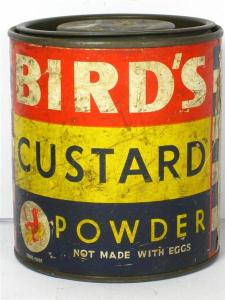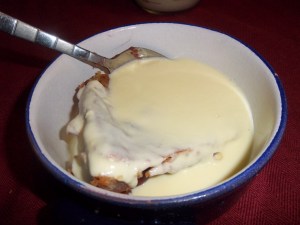By proper custard I mean the pourable kind that goes on your pie, crumble or steam pudding. It also assumes the name cream custard and, of course, crème anglaise; you see it given that name in restaurants that trying to look all ‘high-end’, I suppose in many people’s minds, custard comes out of a packet or tin whilst crème anglaise is the real deal.
Custard in Britain has become somewhat of a travesty over the last few decades and I wonder how many people have actually ever eaten the proper stuff, whatever name you like to call it. I think it appears extravagant, fattening or difficult to make. Well it might be guilty on the first two counts against it because of the egg yolks and cream that are used, but it’s not really that difficult. All it needs is a watchful eye and a little stirring. There ways of making it easier to conjure up, as well as reducing its calorie count and cost, and there is no need to always resort going to the packet or tin.
Now, before you label me a custard snob, I need to point something out: I actually love custard made with custard powder and there’s really nothing wrong with it per se, but until you make the real stuff you won’t see they are almost incomparable. That said, there has been many an evening when I have a made a whole pint of Bird’s custard and eaten the whole lot to myself, but if there are people coming round for food, I always get the vanilla and egg yolks out.
Bird’s custard was my first contact so it will always have a special place in both my heart and stomach. However, technically, Bird’s custard isn’t custard at all, for it contains no egg (see the main post on custard). The powder was invented by Alfred Bird in 1837 because his wife, though she liked custard, was terribly allergic to eggs. Bird’s custard powder is simply cornflour with some vanilla flavouring and colouring. The famous three birds logo wasn’t introduced until the 1920s, surprisingly.
Tinned custard is pretty good too and, up until the last five or so years, it was the form I bought custard in if I wanted proper custard. My tinned custard of choice? Ambrosia Devon Custard of course – nothing else would do – and, like the Bird’s, I still love it. Again, however, Ambrosia custard does not contain eggs or egg products so is not proper custard.
Now you can go off and buy the proper stuff in the refrigerator section of your local supermarket, always called crème anglaise of course, but you may as well make your own if you’re going to do that. Next time you make a trifle or a nice warm pudding, why not try making the real thing – England’s only sauce as the French call it – proper custard.
If you like the blogs and podcast I produce, please consider treating me to a virtual coffee or pint, or even a £3 monthly subscription: follow this post for more information.
It’s a recipe that goes far, far back and I gave an early recipe a few posts ago (see here). I hope to try some old recipes in the near future. These days vanilla is the typical flavouring, whether it be in the form of a pod, an extract or as vanilla sugar, but it is optional. Some like no spice or some go for an alternative like nutmeg or cinnamon. For me, vanilla is the only way. It is sweetened with sugar and the amount you add depends on your own taste, but as a rule I like sweet custard, especially when it’s with a tart fruit pie or crumble or with a stodgy suet pudding. I add less sugar if the dessert is very sweet, like treacle tart or sticky toffee pudding.
When it comes to thickening the custard, you need to be careful not to over-cook it as it results in curdling. If you are new to custard making, the best thing to do is to replace two yolks with two teaspoons of cornflour; it works as a thickener like the yolks, but it also stabilises everything, so you’re less likely to make an error. The recipe below uses six egg yolks, but if you want thicker custard add another, or another teaspoon of cornflour.
Ingredients
1 pint of milk, or a mixture of milk and cream
1 vanilla pod or ¼ teaspoon of vanilla extract
6 egg yolks or 4 egg yolks and 2 tsp cornflour
1 to 2 tbs sugar
Split the vanilla pod, if using, and scrape out the seeds and add to a saucepan along with the milk and cream. Bring slowly to almost boiling point. Meanwhile beat the egg yolks, cornflour and sugar together in a bowl.
When the milk and cream are scalding hot and about to boil, pour it quickly onto the egg mixture whilst vigorously beating with a whisk. Tip the custard back into the saucepan and stir over a very low heat for a few minutes until it thickens and coats the back of your wooden spoon. On no account, let the custard boil, otherwise you will get scrambled egg. The temperature you are looking to achieve is 81⁰C (178⁰F). So if you are worried that it will curdle, either make sure you include the cornflour and/or put the custard in a bowl over a pan of simmering water. Don’t worry if there is a little curdling; simply pass it through a sieve and everyone will be none the wiser.






So how do I decide whether to use cream and milk or milk alone? Is it purely a calorie thing? Is cream always better?
LikeLike
I do half cream, half milk normally. If i’m feeling extravagant I’ll do just cream. It’s partly taste too. Being in America, half-and-half is probably the perfect thing to use….
LikeLike
Pingback: Custard | British Food: A History
Pingback: The Rhubarb Triangle | British Food: A History
Pingback: A good egg? | British Food: A History
Two tricks which make it easier to get right: keeping a food thermometre in the custard, and having two pots, one inside the other. The inside pot has the custard in, the outside one goes on the stove, is filled with water and has a cloth at the bottom to prevent the pot with the custard in it from coming too close to the heat below.
LikeLike
I have never heard of the cloth method before so thanks for that. I haven’t made any custard for a while, but I’ll try it next time I do (if the heatwave we’re in here in St Louis ever goes away!)
LikeLike
Pingback: Spotted Dick | British Food: A History
Been making my own custard for donkey’s years but like the blogger, I’ve been known to eat a tin of Ambrosia all by myself lol. My late mother always made Trifle using Bird’s “custard” but I make custard from scratch. My friends, like myself from Britain, always tell me that the colour of the custard in the trifle is “wrong” And I tell them that it’s the food colouring in Birds that their Mums put into the trifle. If your eggs are very orange ( fresh) you may get a hint of colour but it normally will be a lovely cream.
LikeLike
Thanks for the comment, Leah! Custard is great in whatever form it is in, it’s just all shades of deliciousness!
LikeLike
Pingback: Medlar Tart | British Food: A History
Pingback: Jam Roly-Poly | British Food: A History
Pingback: Gooseberries | British Food: A History
Pingback: Baked Gooseberry Pudding | British Food: A History
Pingback: Elderflowers | British Food: A History
Pingback: Apple Hat | British Food: A History
Pingback: To Make a Christmas Pudding Part 2: the Big Day | British Food: A History
Pingback: How to Make a Steamed Sponge Pudding: a Step-by-Step Guide | British Food: A History